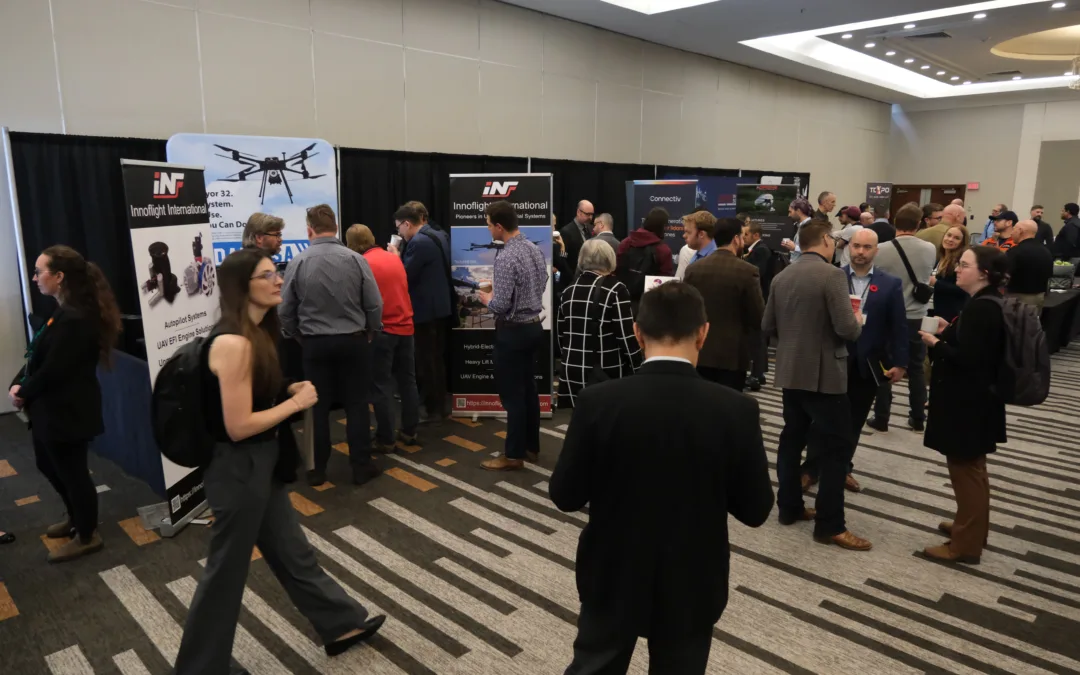By Scott Simmie
What a great show.
The Aerial Evolution Association of Canada (formerly Unmanned Systems Canada – Systèmes Télécommandés Canada) held its annual conference and trade exhibition November 7-10 in Ottawa. The event had an excellent turnout, along with the usual selection of high-quality learning sessions.
There was plenty of discussion around the coming world of Advanced Air Mobility, where new and transformative aircraft (many of which are innovative new autonomous drone designs with detect-and-avoid features) will routinely deliver heavy cargo and even passengers over dense urban centres and to regional communities not currently served by traditional aircraft.
Another timely topic was the increasing use of drones in the conflict in Ukraine, as well as the latest developments in Counter-UAS technologies (including both detection and mitigation). There was even a live demonstration of a new kinetic C-UAS drone that uses a net to disable and capture a rogue RPAS.
Reps from Transport Canada and NAV Canada were on hand to discuss proposed changes on the regulatory landscape and – always an important part of these gatherings – hear questions and concerns directly from the industry. These open exchanges have long been a hallmark of the annual event.

FIRST NATIONS
There was a notable emphasis this year on Indigenous use of drones and other technologies, including a powerful session about detecting unmarked burial sites on the grounds of former residential schools. The concept of data sovereignty – who owns data captured on unceded territories – was also discussed. There was even a presentation on how drones have helped to capture important First Nations cultural events. Plus, of course, the employment and opportunities that RPAS education and initiatives are creating for Indigenous entrepreneurs and communities.
Below, one of the Indigenous panels, moderated by Kristin Kozuback (C)
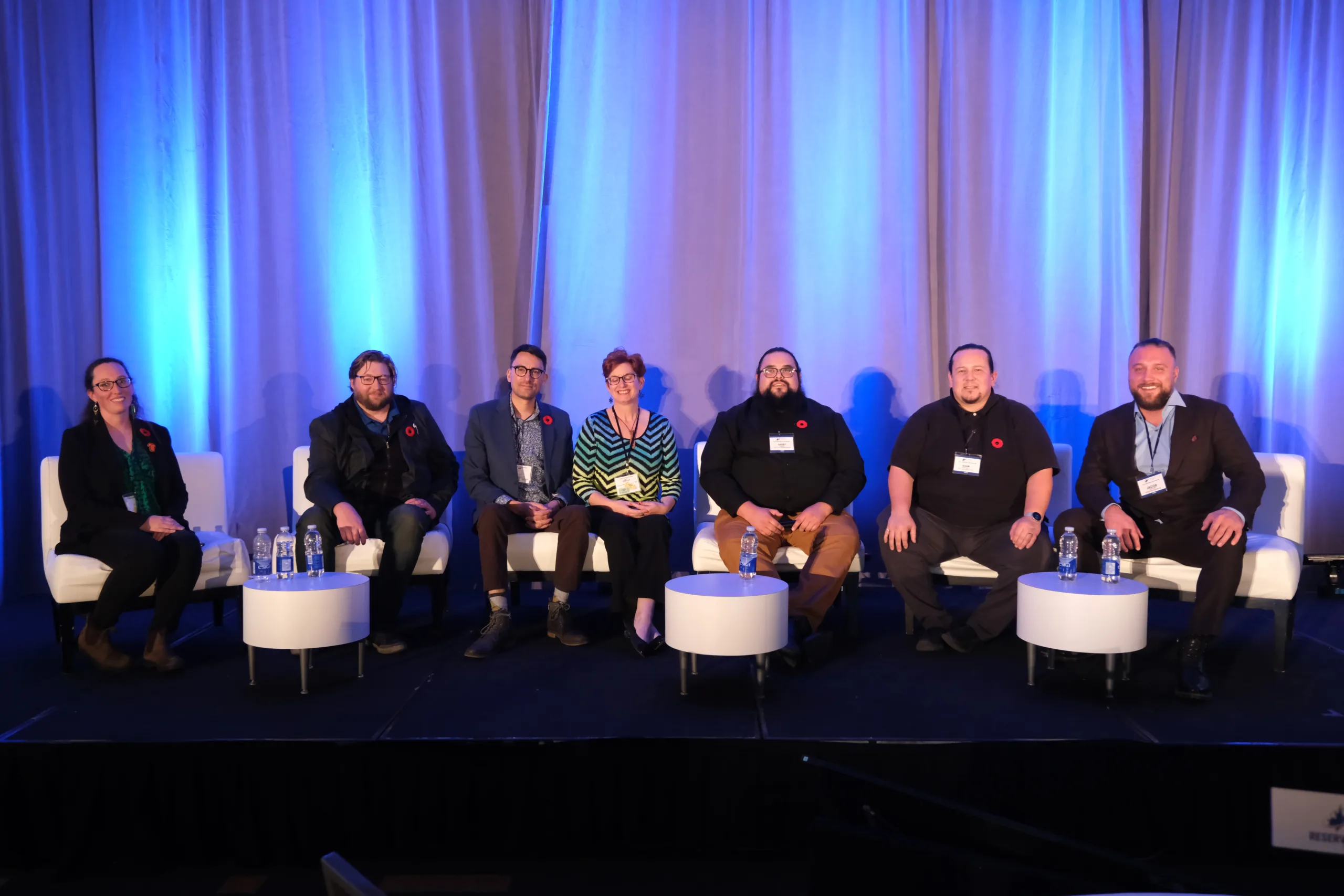
DRONES AND LAND MINES
SAIT‘s Shahab Moeini talked about a program using UAS to detect land mines using AI, machine vision and sensor fusion. Many previous and current efforts have used magnetometers, but these metal-detecting sensors are neither effective nor appropriate given that many land mines are made of plastics and other non-metallic materials. Machine Learning is being used to train drones to recognise the many, many, different types of land mines – even if only a portion of the device is visible above ground.
“Land mines,” said Moeini, “are the nastiest creation of mankind.”
Below: Shahab Moeini, who runs SAIT’S Centre for Innovation and Research in Unmanned Systems (CIRUS)
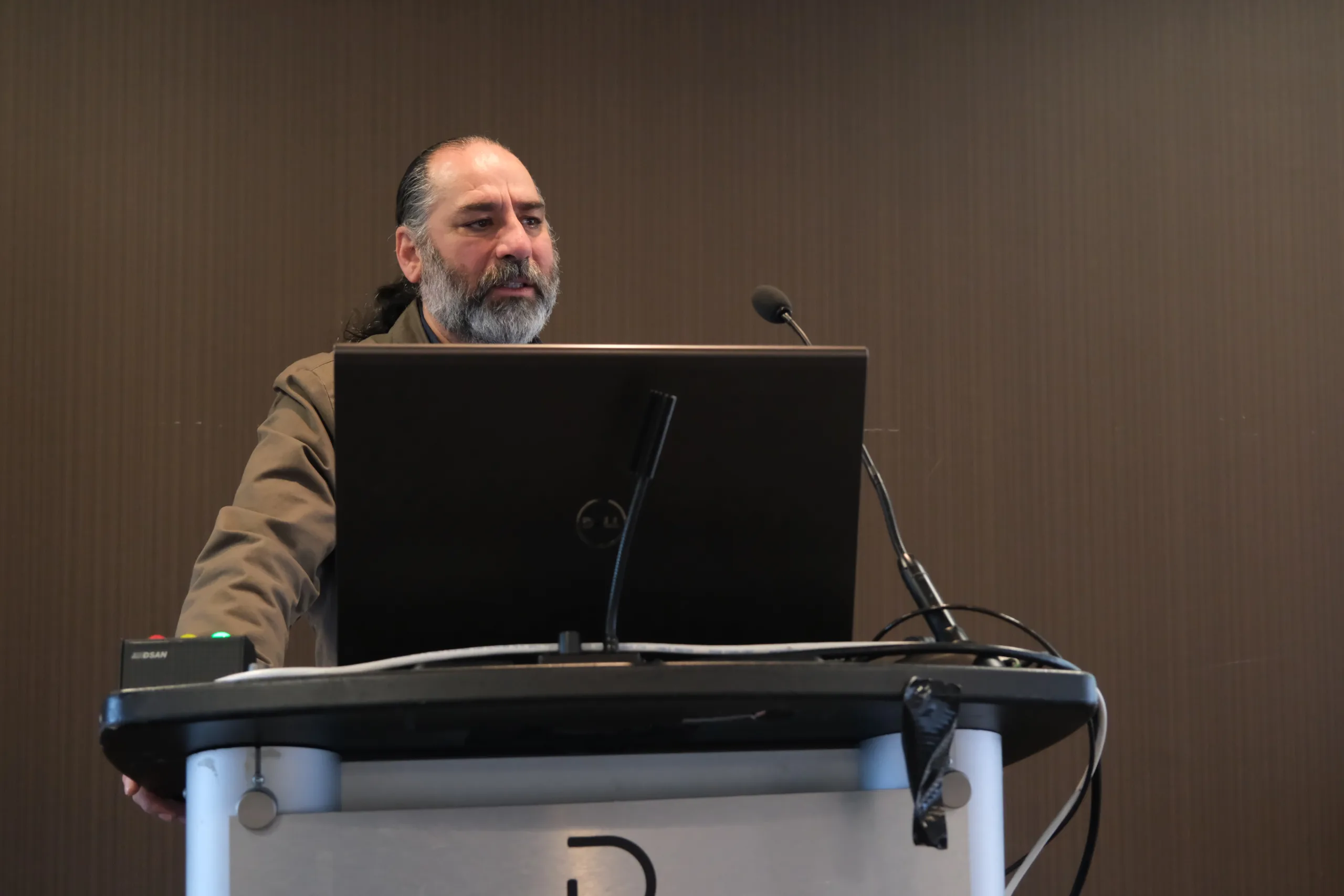
SPEXI
Among the many excellent and innovative presentations, one by Spexi Geospatial caught our attention. The Vancouver-based company has built software that allows pilots of micro-drones to automatically fly and capture hexagonal-shaped areas the company calls “Spexigons.” Each Spexigon covers 22 acres and when an adjacent Spexigon is flown the data and imagery are seamlessly connected. With enough Spexigons captured, you’ve got a high-resolution version of Google Earth – and a ton of use-cases for the data.
The Spexi software carries out the flights automatically using DJI sub-250g drones, flying standardized capture missions to produce imagery at scale. The data is uploaded to the cloud where it’s stitched together to form highly detailed images of very large areas with a resolution of 3cm/pixel. (A satellite, by contrast, captures at 30cm/pixel while a standard airplane generally captures at 10cm/pixel.)
During one recent mission, “over 10,000 acres of imagery was captured in three days,” explained Spexi COO Alec Wilson.
“We’ve made it super simple to get images in and out at scale… And we’re super-excited to be able to start building bigger and better platforms for the drone industry.”
Below: Spexi’s Alec Wilson explains how the system works…
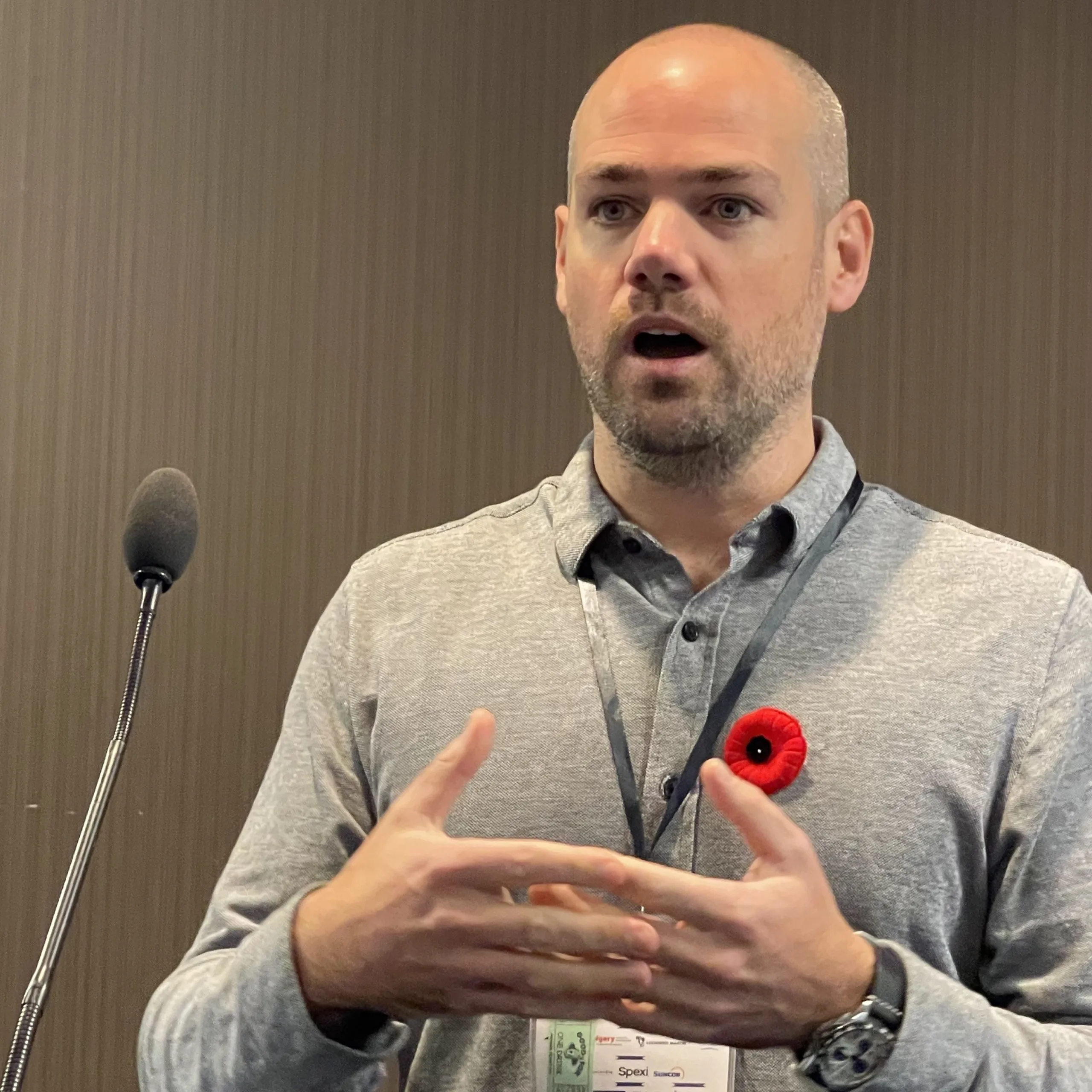
WOMEN IN DRONES
This year’s conference saw an increased emphasis on Women in Drones.
Though this has been on the agenda at past events, the 2023 event had somehow a different feel: The recognition that women are not only increasingly entering and shaping this male-dominated sector, but that many are high-level subject matter experts making significant contributions.
While progress has been made, there’s still work to do on the equity front. And there was a strong sense the AEAC is committed to achieving that.
Below: The close of the Women in Drones breakfast
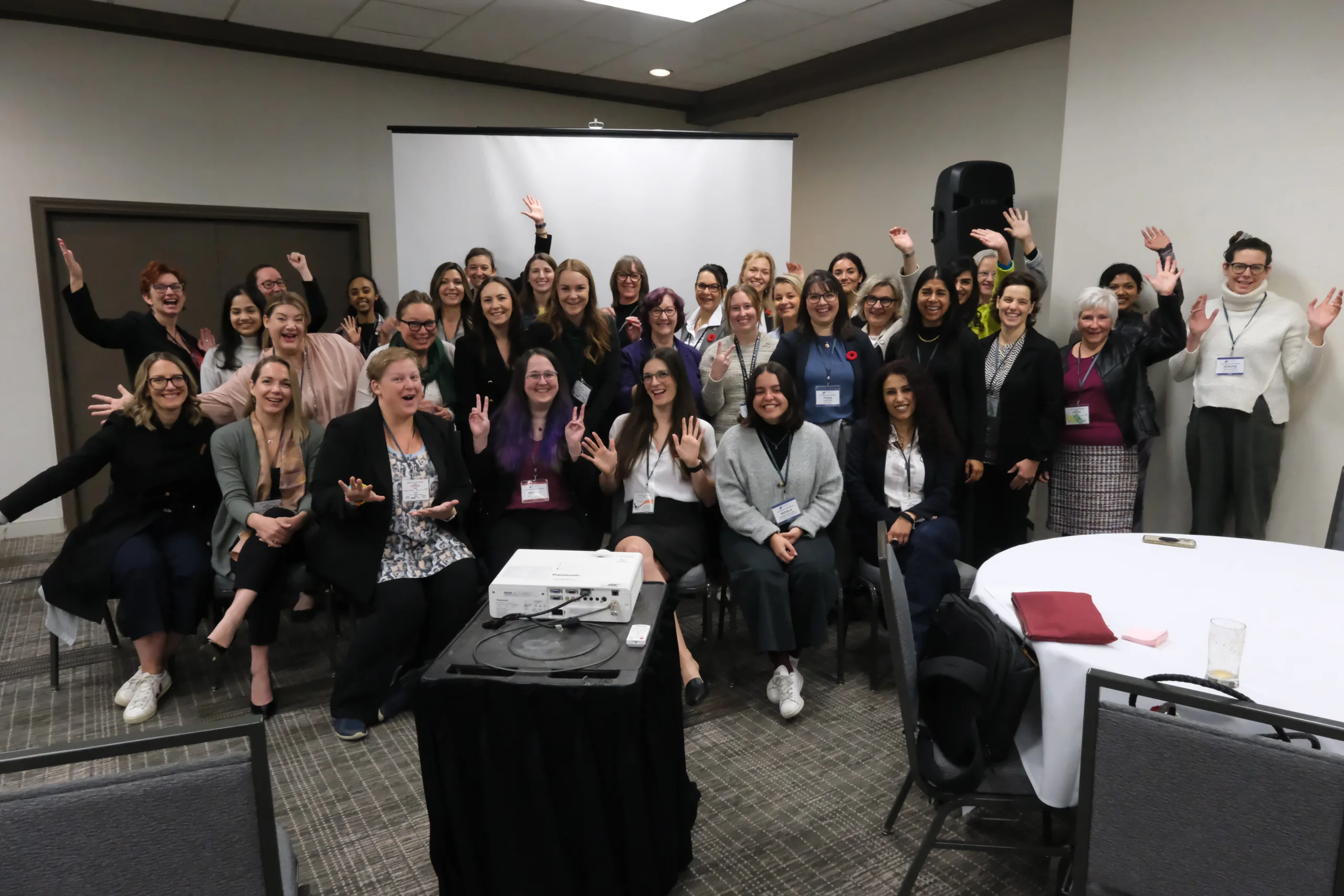
RECOGNITION
One of the most memorable parts of any Aerial Evolution Association of Canada conference is the awards ceremony. Individuals and organizations that have made outstanding contributions to the RPAS industry are nominated, voted for by their peers, and selected for recognition. Recipients range from student engineers (the RPAS CTOs of tomorrow) through to service providers, manufacturers – and even government agencies.
Those honoured at this year’s conference include:
- Dr. Frederique Pivot: Pip Rudkin Individual Achievement Award
- Jacob Taylor: 2023 Indigenous Innovation Award
- National Research Council of Canada Aerospace Research Centre: 2023 Organizational Achievement Award
- Bryan Kikuta, Toronto Metropolitan University: 2023 Mark Cuss Memorial Scholarship
- Ana Pereira, University of Victoria: Best Student Oral Presentation Award (judged)
- Aman Basawanal, Carleton University: Best Student Technical Paper Award (judged)
Below: The National Research Council Team receives its award
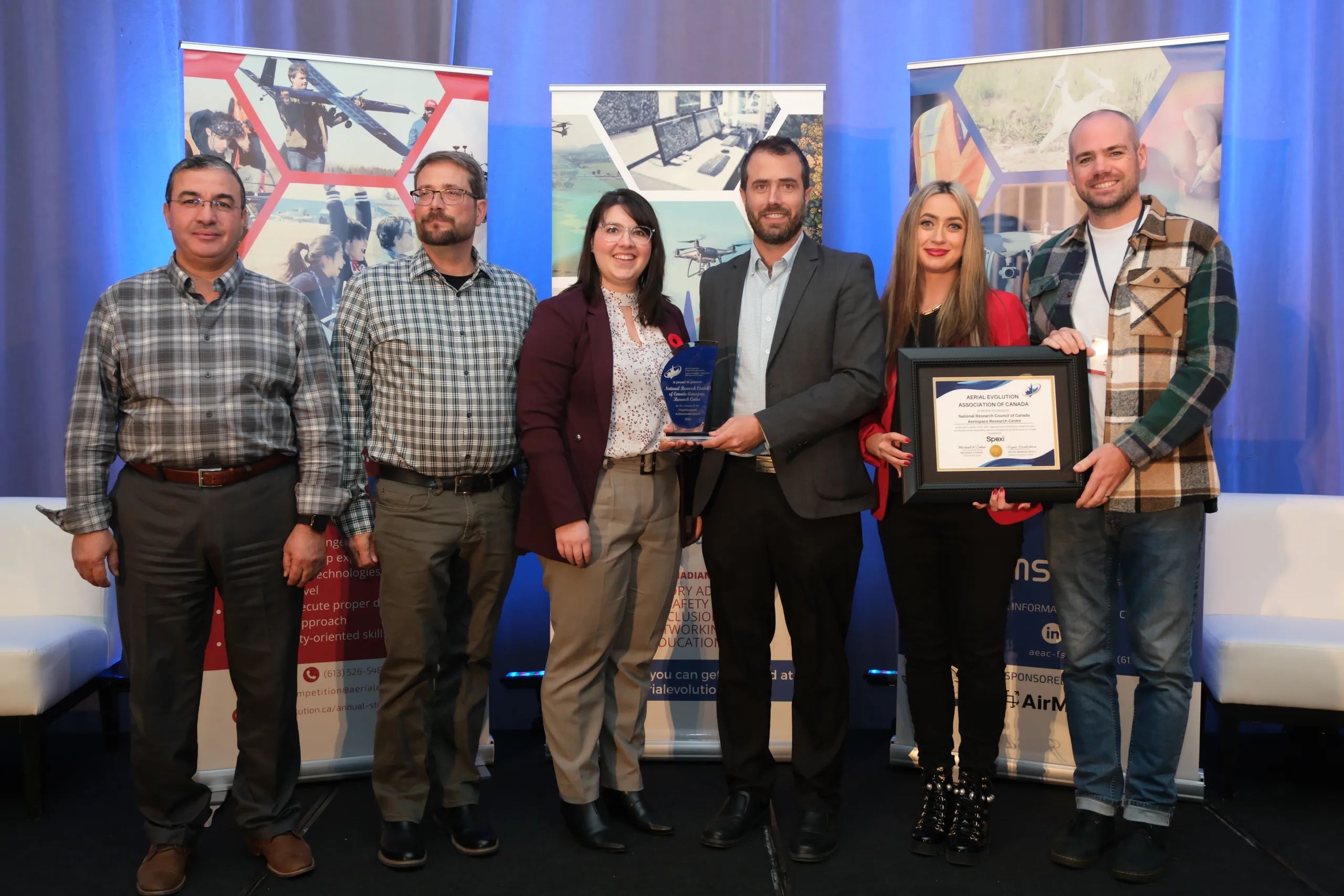
WAIT, THERE’S MORE
There was one more award recipient to whom we’d like to give a special shout-out. It’s Katelin (Kate) Klassen, who received the 2023 Aerial Evolution Ellevatus Award “for her outstanding dedication in uplifting, empowering, and inspiring women in the Canadian RPAS sector.”
Kate is truly a pioneer in this field. A multi-rated private pilot and flight instructor with traditional aircraft, Kate has been a significant force in the drone field for years. She’s an educator (her online courses have trained more than 10,000 pilots), a lobbyist (she’s taken part in multiple consultations with regulators – including being co-chair of the CanaDAC Drone Advisory Committee), and a true advocate for RPAS education. Her knowledge of the Canadian Aviation Regulations (CARs) is legendary – and she has inspired and encouraged countless women (and men) in this industry.
Plus, she’s truly an all-round awesome human being – always willing to share her time and expertise. Congratulations, Kate – and all the other winners!
Kate (C) looking justifiably happy…
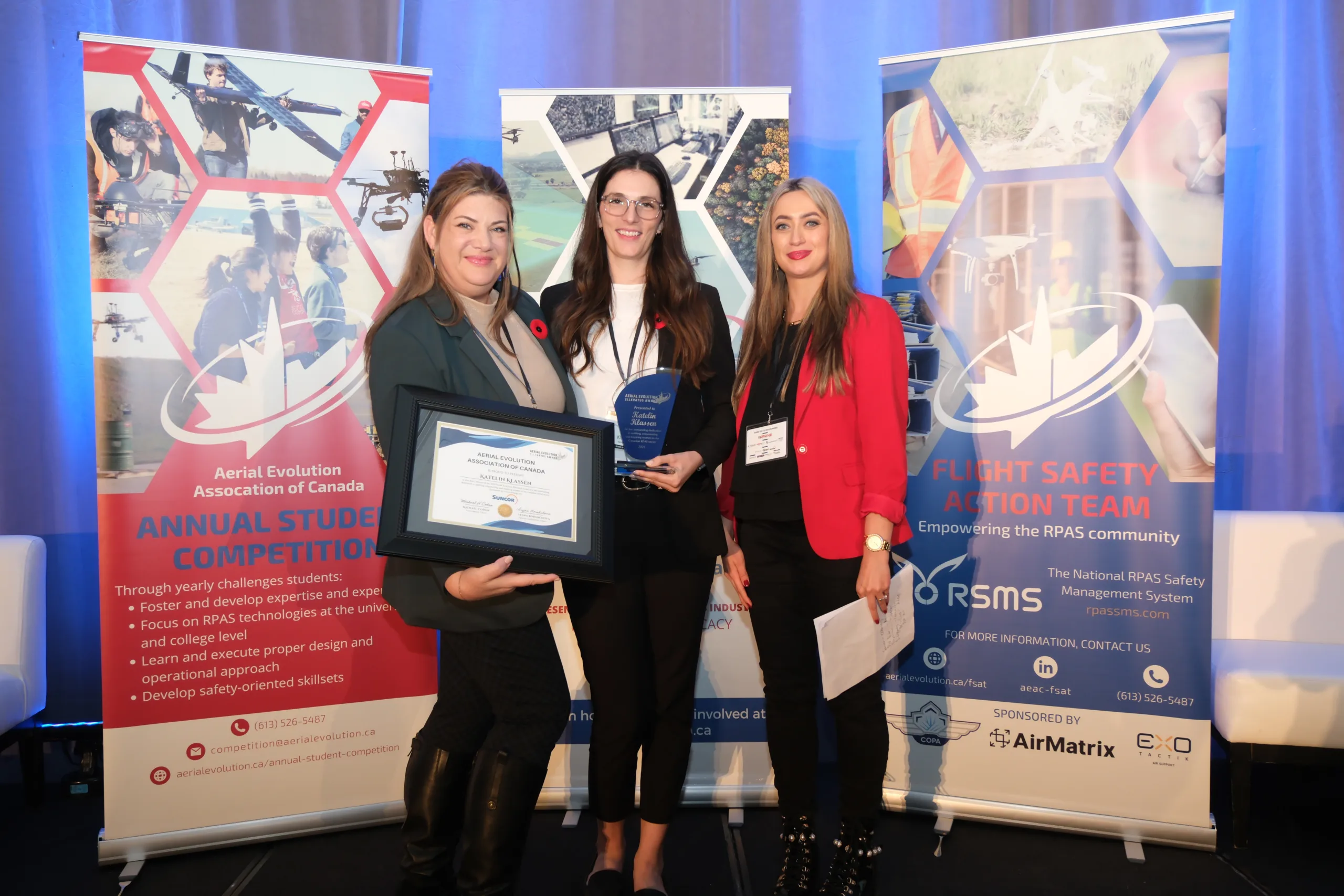
ALSO WORTH NOTING (AND CELEBRATING)
Though they didn’t receive any awards, three key members of the Association certainly merit public recognition for their contributions. Jordan Cicoria (CEO of Aerium Analytics) did an outstanding job as Conference Chair. In fact, he’s overseen the last two in-person conferences, while also taking the helm of the virtual gathering during the peak of the pandemic. That’s a *lot* of work, and Jordan has carried out these tasks both professionally and modestly while juggling a plethora of moving parts.
A lot of work on the conference – and elsewhere – came from AEAC Executive Director Declan Sweeney. Declan worked hard behind the scenes (and on countless calls) with sponsors, exhibitors, membership drives – you name it. He’s also deeply involved in the annual student competition. Declan does it all with professionalism, and a great sense of humour.
Equally deserving of recognition is AEAC Chair of the Board Michael Cohen (also the CEO of Qii.AI).
Michael has been serving the Association well, and was key in the transition and rebranding from Unmanned Systems Canada / Systèmes Télécommandés Canada to the Aerial Evolution Association of Canada. This was far more than a name change, but an organizational shift to reflect the coming era of Advanced Air Mobility. He’s been instrumental in the Association’s push toward greater Diversity, Equity and Inclusion – which was reflected in the conference agenda.
The Association also benefits greatly from Michael’s extensive knowledge and background; he’s a former commercial jet pilot – a distinct advantage when discussing the Big Picture (and the minutia) with regulators.
Thank you, all.
Below: Jordan Cicoria (L) with Declan Sweeney, followed by Michael Cohen (R) with Transport Canada’s Ryan Coates

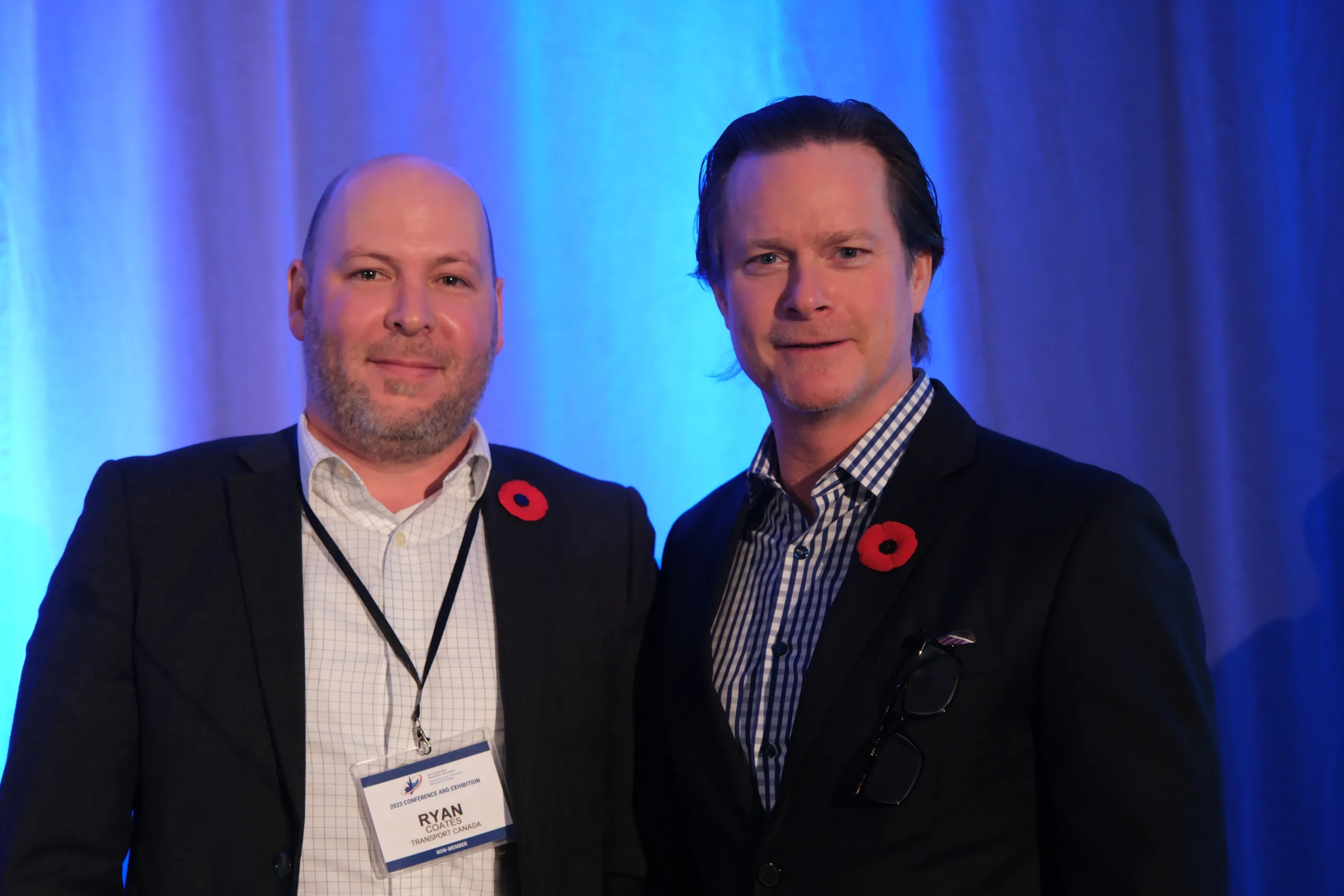
INDRO’S TAKE
As always, we were pleased to participate at the annual Aerial Evolution Association of Canada conference. In addition to the sessions, the networking and the trade exhibit – it’s of tremendous value to have the industry and the regulators together for collaborative discussions. There’s been tremendous progress in this sector over the past decade, and much of that is due to regulators truly working with the industry to safely advance RPAS use in Canadian airspace, including BVLOS flight and other more complex operations. Technology that was seen almost as a threat in the early days is now being accepted as a useful – and critical – adjunct to the overall world of aviation.
InDro Robotics staff appeared on multiple panels; CEO and AEAC Board Member Philip Reece, pictured below, took part in the Counter-UAS panel and a live demo of kinetic C-UAS drone at Area X.O‘s Drone and Advanced Robotics Training and Testing (DARTT) facility. (That’s Philip below.)
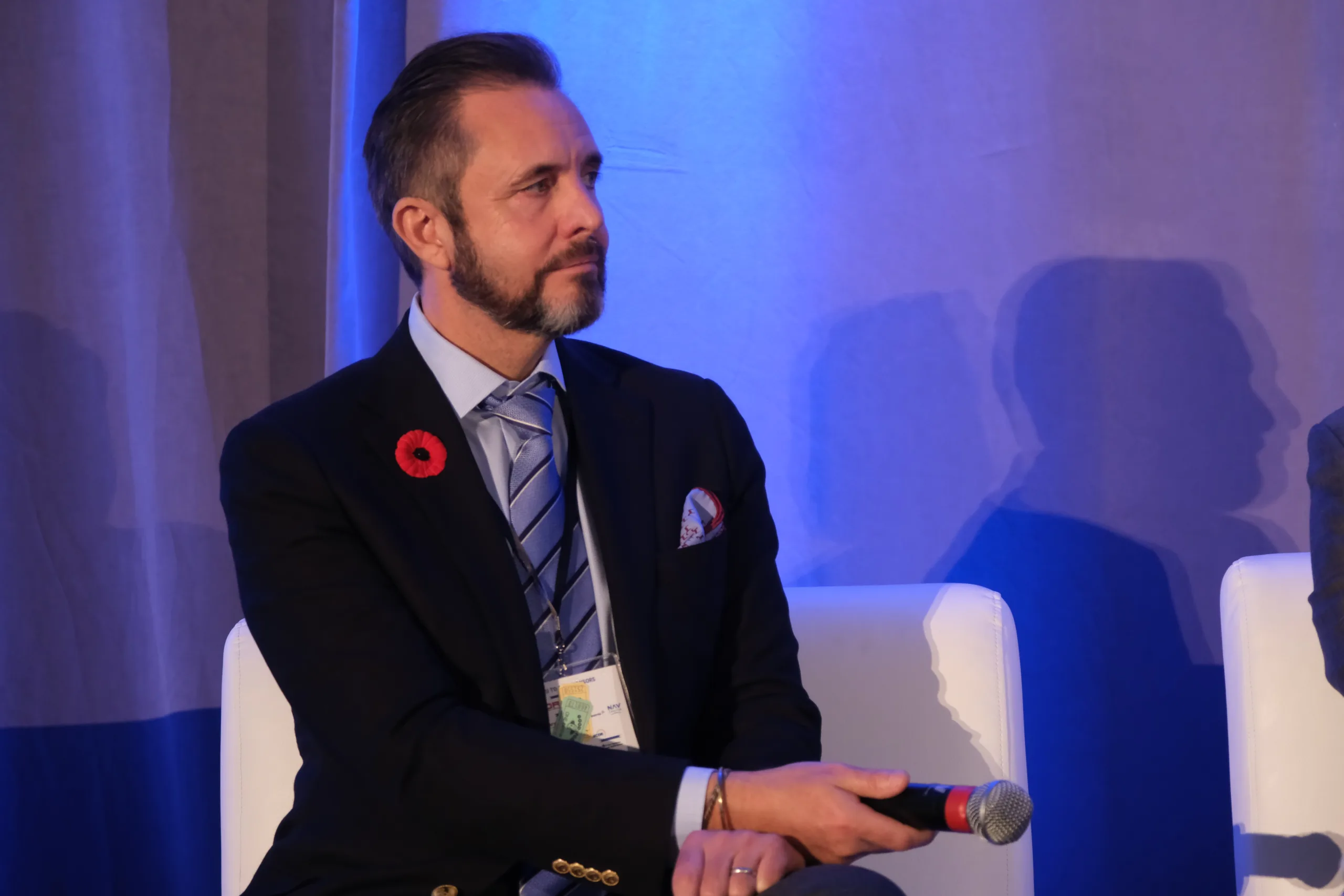
BUT…
We’d be lying if we didn’t tell you that a true highlight for us was seeing Kate Klassen receive the Ellevatus Award.
“One might easily conclude we’re happy simply because Kate is a flight instructor and regulatory expert with InDro Robotics,” says CEO Philip Reece. “But that’s really just a sliver of the truth. Kate’s contributions over the years have been plentiful, significant, and lasting. We’d be applauding this recognition just as loudly even if she didn’t work with InDro.”
We are, however, very happy – and fortunate – that she does.

